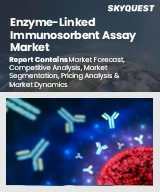
세계의 효소 결합 면역 흡착 측정법 시장 규모는 2023년에 24억 달러로 평가되며, 예측 기간(2025-2032년)의 CAGR은 5.1%로, 2024년 25억 달러에서 2032년에는 35억 달러로 성장할 전망입니다.
세계 효소 결합 면역 흡착 분석법(ELISA) 시장은 만성질환 및 감염성 질환의 확산, 분석 기술의 발전, 신약 개발 및 식품 안전에 대한 폭넓은 응용으로 인해 크게 성장하고 있습니다. ELISA는 항원이나 항체를 정확하게 정량화할 수 있으므로 예방에 중점을 두고 진화하는 헬스케어에서 적시에 진단과 개입을 가능하게 하는 매력이 있습니다. 또한 백신 개발 및 품질관리의 중요한 역할은 제약 기업 사이에서 그 관련성을 높이고 있습니다. 시장은 또한 인공지능, 머신러닝, IoT의 통합으로 진단 정확도와 검사실 효율성을 향상시키는 혁신의 시기를 맞이하고 있습니다. 이러한 기술을 통해 ELISA는 진화하는 진단 환경에서 필수적인 최첨단 툴로 자리매김하고 있으며, 신뢰할 수 있는 결과에 대한 수요 증가에 부응하고 있습니다.
Global Enzyme-Linked Immunosorbent Assay Market size was valued at USD 2.4 Billion in 2023 and is poised to grow from 2.5 USD Billion in 2024 to USD 3.5 Billion by 2032, growing at a CAGR of 5.1% in the forecast period (2025-2032).
The global enzyme-linked immunosorbent assay (ELISA) market is experiencing significant growth driven by the increasing prevalence of chronic and infectious diseases, advancements in assay technologies, and a broader range of applications in drug discovery and food safety. ELISA's precision in quantifying antigens and antibodies enhances its appeal for timely diagnosis and intervention in an evolving healthcare landscape focusing on prevention. Furthermore, its vital role in vaccine development and quality control bolsters its relevance among pharmaceutical organizations. The market is also undergoing transformation through the integration of artificial intelligence, machine learning, and IoT, which improve diagnostic accuracy and laboratory efficiency. These technologies ensure ELISA remains an indispensable, cutting-edge tool in the evolving diagnostic landscape, catering to rising demand for reliable results.
Top-down and bottom-up approaches were used to estimate and validate the size of the Global Enzyme-Linked Immunosorbent Assay market and to estimate the size of various other dependent submarkets. The research methodology used to estimate the market size includes the following details: The key players in the market were identified through secondary research, and their market shares in the respective regions were determined through primary and secondary research. This entire procedure includes the study of the annual and financial reports of the top market players and extensive interviews for key insights from industry leaders such as CEOs, VPs, directors, and marketing executives. All percentage shares split, and breakdowns were determined using secondary sources and verified through Primary sources. All possible parameters that affect the markets covered in this research study have been accounted for, viewed in extensive detail, verified through primary research, and analyzed to get the final quantitative and qualitative data.
Global Enzyme-Linked Immunosorbent Assay Market Segments Analysis
The global enzyme-linked immunosorbent assay market is segmented into product type, applications, technology, end users, and region. By product type, the market is categorized into kits, reagents, and instruments. Depending on application, it is classified into clinical diagnostics, research, veterinary, and others. Based on technology, it is divided into sandwich ELISA, indirect ELISA, competitive ELISA, and direct ELISA. Based on end user, it is categorized into hospitals, diagnostic laboratories, research institutes, and others. Regionally, it is analyzed across North America, Europe, Asia-Pacific, Latin America, and the Middle East and Africa.
Driver of the Global Enzyme-Linked Immunosorbent Assay Market
A key market driver for the Global Enzyme-Linked Immunosorbent Assay (ELISA) Market is the increasing prevalence of chronic diseases and the rising demand for accurate diagnostic tools. As healthcare systems worldwide strive for improved disease management and early detection, ELISA techniques are gaining prominence due to their sensitivity, specificity, and versatility in detecting a range of biomarkers. This trend is further amplified by advancements in biotechnology and pharmaceuticals, which are driving research and development of novel assays. Additionally, the growing emphasis on personalized medicine and preventive healthcare is propelling the demand for ELISA tests in clinical and research settings.
Restraints in the Global Enzyme-Linked Immunosorbent Assay Market
One of the key market restraints for the global enzyme-linked immunosorbent assay (ELISA) market is the high cost associated with advanced ELISA diagnostic kits and necessary laboratory equipment. These expenses can limit accessibility for smaller laboratories and healthcare facilities, especially in developing regions where budget constraints are more pronounced. Additionally, the complexity of ELISA procedures may require specialized training for personnel, further compounding costs and contributing to the potential inefficiencies in workflow. As a result, these financial and logistical challenges may hinder the widespread adoption of ELISA technologies, impacting market growth and innovation.
Market Trends of the Global Enzyme-Linked Immunosorbent Assay Market
The Global Enzyme-Linked Immunosorbent Assay (ELISA) market is witnessing a significant trend towards the adoption of automated and high-throughput platforms. Laboratories and diagnostic centers are increasingly integrating advanced automated ELISA analyzers, which enhance efficiency by automating processes such as plate loading, reagent dispensing, and result reporting. This automation mitigates human error and accelerates turnaround times, making it particularly advantageous in high-demand contexts like pharmaceutical research and vaccine development, where processing large volumes of samples swiftly is essential. This shift towards automation is poised to transform ELISA applications, contributing to improved diagnostics and research outcomes across various sectors.